2009 MITSUBISHI ASX warning
[x] Cancel search: warningPage 56 of 368
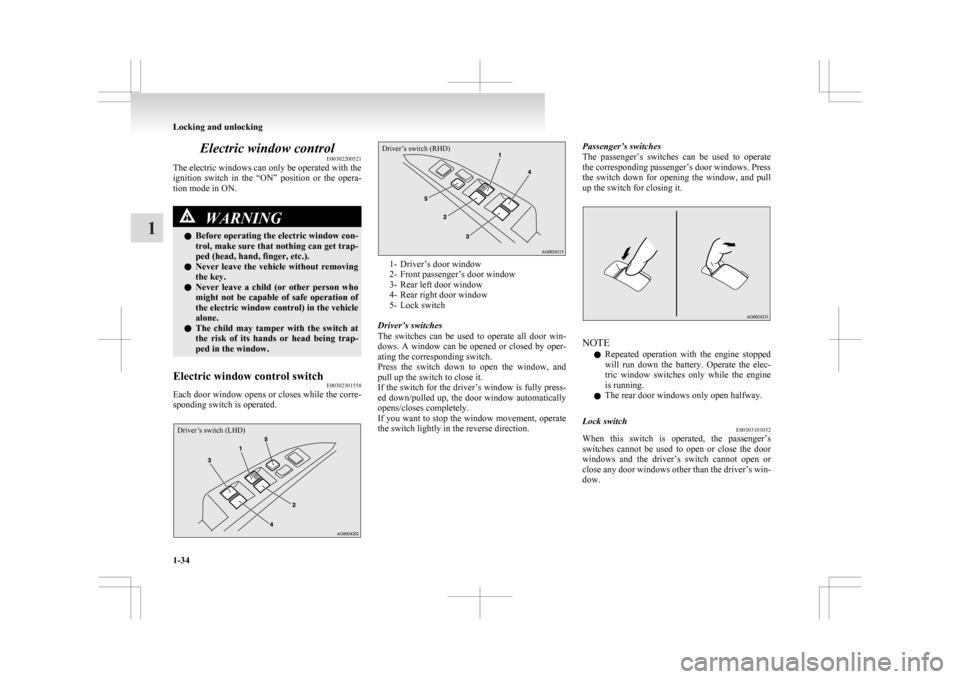
Electric window control
E00302200521
The electric windows can only be operated with the
ignition
switch in the “ON” position or the opera-
tion mode in ON. WARNING
l Before
operating the electric window con-
trol, make sure that nothing can get trap-
ped (head, hand, finger, etc.).
l Never leave the vehicle without removing
the key.
l Never leave a child (or other person who
might not be capable of safe operation of
the electric window control) in the vehicle
alone.
l The child may tamper with the switch at
the risk of its hands or head being trap-
ped in the window.
Electric window control switch E00302301558
Each door window opens or closes while the corre-
sponding switch is operated.
Driver’s switch (LHD)
Driver’s switch (RHD) 1- Driver’s door window
2-
Front passenger’s door window
3- Rear left door window
4- Rear right door window
5- Lock switch
Driver’s switches
The switches can be used to operate all door win-
dows. A window can be opened or closed by oper-
ating the corresponding switch.
Press the switch down to open the window, and
pull up the switch to close it.
If the switch for the driver’s window is fully press-
ed down/pulled up, the door window automatically
opens/closes completely.
If you want to stop the window movement, operate
the switch lightly in the reverse direction. Passenger’s switches
The
passenger’s switches can be used to operate
the corresponding passenger’s door windows. Press
the switch down for opening the window, and pull
up the switch for closing it. NOTE
l Repeated
operation with the engine stopped
will run down the battery. Operate the elec-
tric window switches only while the engine
is running.
l The rear door windows only open halfway.
Lock switch E00303101032
When this switch is operated, the passenger’s
switches
cannot be used to open or close the door
windows and the driver’s switch cannot open or
close any door windows other than the driver’s win-
dow. Locking and unlocking
1-34
1
Page 57 of 368
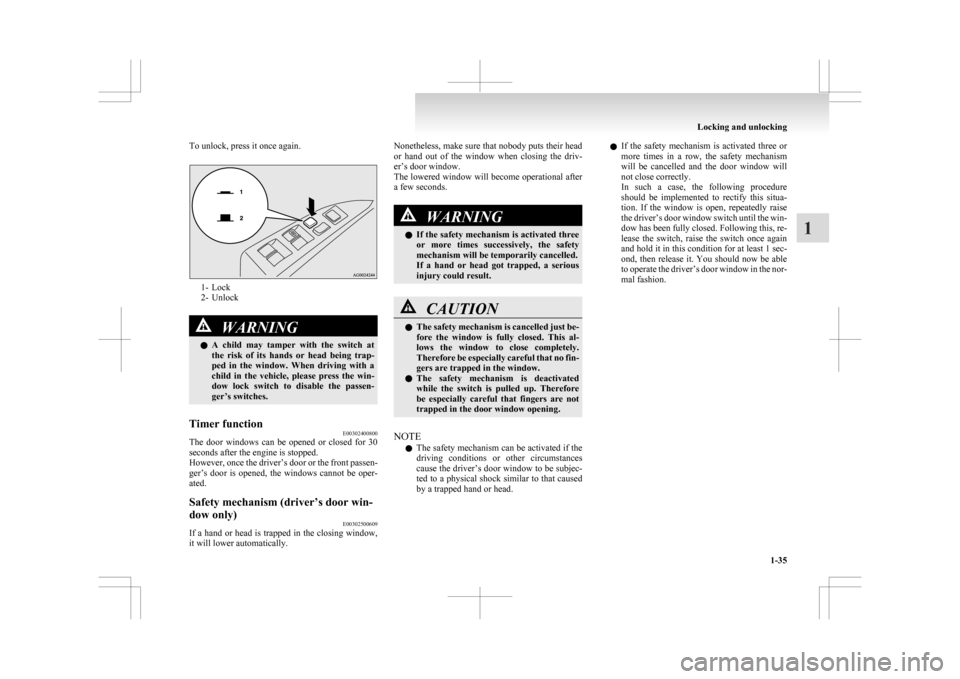
To unlock, press it once again.
1- Lock
2-
Unlock WARNING
l A
child may tamper with the switch at
the risk of its hands or head being trap-
ped in the window. When driving with a
child in the vehicle, please press the win-
dow lock switch to disable the passen-
ger’s switches.
Timer function E00302400800
The door windows can be opened or closed for 30
seconds after the engine is stopped.
However,
once the driver’s door or the front passen-
ger’s door is opened, the windows cannot be oper-
ated.
Safety mechanism (driver’s door win-
dow only) E00302500609
If a hand or head is trapped in the closing window,
it will lower automatically. Nonetheless, make sure that nobody puts their head
or
hand out of the window when closing the driv-
er’s door window.
The lowered window will become operational after
a few seconds. WARNING
l If
the safety mechanism is activated three
or more times successively, the safety
mechanism will be temporarily cancelled.
If a hand or head got trapped, a serious
injury could result. CAUTION
l
The
safety mechanism is cancelled just be-
fore the window is fully closed. This al-
lows the window to close completely.
Therefore be especially careful that no fin-
gers are trapped in the window.
l The safety mechanism is deactivated
while the switch is pulled up. Therefore
be especially careful that fingers are not
trapped in the door window opening.
NOTE l The
safety mechanism can be activated if the
driving conditions or other circumstances
cause the driver’s door window to be subjec-
ted to a physical shock similar to that caused
by a trapped hand or head. l
If
the safety mechanism is activated three or
more times in a row, the safety mechanism
will be cancelled and the door window will
not close correctly.
In such a case, the following procedure
should be implemented to rectify this situa-
tion. If the window is open, repeatedly raise
the driver’s door window switch until the win-
dow has been fully closed. Following this, re-
lease the switch, raise the switch once again
and hold it in this condition for at least 1 sec-
ond, then release it. You should now be able
to operate the driver’s door window in the nor-
mal fashion. Locking and unlocking
1-35 1
Page 58 of 368

Sunshade*
E00302800279WARNING
l Never leave a child (or other person who
might not be capable of safe operation of
the sunshade switch) in the vehicle alone.
l Before operating the sunshade, make
sure that nothing can be trapped (head,
hand, finger, etc.).
l Do not bring your head, hand, finger, etc.
near the opening edge of the sunshade re-
ceptacle while the vehicle is in motion.
It may cause injury to your head, hand,
finger, etc. in the event of sudden braking. CAUTION
l
Do
not place heavy luggage on the panor-
amic glass roof. Doing so could damage
the glass roof.
l Do not hang heavy luggage from, allow a
person to hang onto, or apply any other
strong force to the opening of the sun-
shade receptacle or the parts between the
ceiling and the sunshade opening on ei-
ther side. Doing so could damage the sun-
shade.
NOTE l Release
the switch as soon as the sunshade
reaches the fully open or fully closed position. l
If
the sunshade does not operate when the sun-
shade switch is operated, release the switch
and check whether something is trapped by
the sunshade. If nothing is trapped, we recom-
mend you to have the sunshade checked.
l Operating the sunshade repeatedly with the
engine stationary will run down the battery.
Operate the sunshade while the engine is run-
ning.
l Close the sunshade when parking the vehicle
for a long time. Parking in the hot sun with
the sunshade open will make the vehicle in-
side extremely hot.
The sunshade can only be operated with the igni-
tion switch or the operation mode in ON. 1- Open
2-
Close
3- Stop
To open, press the switch (1).
Press and hold the switch (1), the sunshade automat-
ically opens. Release the switch once the sunshade
starts moving automatically.
To stop the moving sunshade, press the switch (1),
(2) or (3).
To close, press the switch (2).
Press
and hold the switch (2), the sunshade automat-
ically closes. Release the switch once the sunshade
starts moving automatically.
To stop the moving sunshade, press the switch (1),
(2) or (3).
Safety mechanism
If a hand or head is trapped in the closing sun-
shade, it will reopen automatically.
Nonetheless, make sure that nobody brings their
head or hand near the sunshade when opening or
closing.
The opened sunshade will become operational after
a few seconds. CAUTION
l
The
safety mechanism is cancelled just be-
fore the sunshade is fully closed. This al-
lows the sunshade to close completely.
Therefore be especially careful that no fin-
gers are trapped in the sunshade.
NOTE l The
safety mechanism can be activated if the
driving conditions or other circumstances
cause the sunshade to be subjected to a phys-
ical shock similar to that caused by a trapped
hand or head. Locking and unlocking
1-36
1
Page 61 of 368
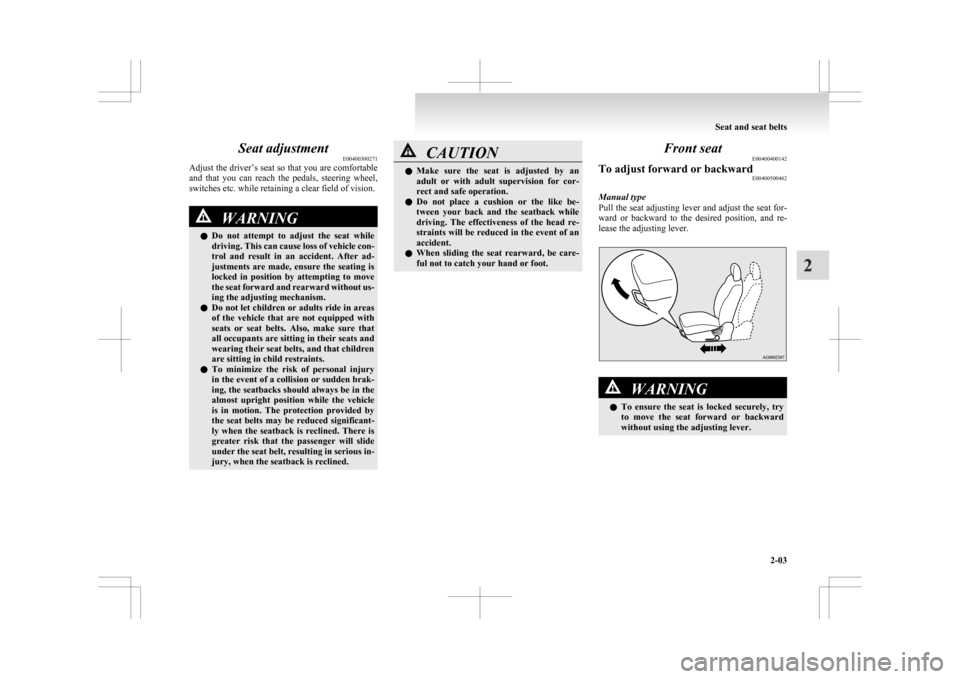
Seat adjustment
E00400300271
Adjust
the driver’s seat so that you are comfortable
and that you can reach the pedals, steering wheel,
switches etc. while retaining a clear field of vision. WARNING
l Do
not attempt to adjust the seat while
driving. This can cause loss of vehicle con-
trol and result in an accident. After ad-
justments are made, ensure the seating is
locked in position by attempting to move
the seat forward and rearward without us-
ing the adjusting mechanism.
l Do not let children or adults ride in areas
of the vehicle that are not equipped with
seats or seat belts. Also, make sure that
all occupants are sitting in their seats and
wearing their seat belts, and that children
are sitting in child restraints.
l To minimize the risk of personal injury
in the event of a collision or sudden brak-
ing, the seatbacks should always be in the
almost upright position while the vehicle
is in motion. The protection provided by
the seat belts may be reduced significant-
ly when the seatback is reclined. There is
greater risk that the passenger will slide
under the seat belt, resulting in serious in-
jury, when the seatback is reclined. CAUTION
l
Make
sure the seat is adjusted by an
adult or with adult supervision for cor-
rect and safe operation.
l Do not place a cushion or the like be-
tween your back and the seatback while
driving. The effectiveness of the head re-
straints will be reduced in the event of an
accident.
l When sliding the seat rearward, be care-
ful not to catch your hand or foot. Front seat
E00400400142
To adjust forward or backward E00400500462
Manual type
Pull
the seat adjusting lever and adjust the seat for-
ward or backward to the desired position, and re-
lease the adjusting lever. WARNING
l To
ensure the seat is locked securely, try
to move the seat forward or backward
without using the adjusting lever. Seat and seat belts
2-03 2
Page 64 of 368

Heated seats*
E00401100960
The
heated seats can be operated with the ignition
switch or the operation mode in ON. The indica-
tion lamp (A) will illuminate while the heater is on. 1 (HI) - Heater high (for quick heating).
2 - Heater off.
3 (LO) - Heater low (to keep the seat warm).
CAUTION
l
Switch off seat heaters when not in use.
l Operate
in the high position for quick heat-
ing. Once the seat is warm, set the heater
to low to keep it warm. Slight variations
in seat temperature may be felt while us-
ing the heated seats. This is caused by the
operation of the heater’s internal thermo-
stat and does not indicate a malfunction.
l If the following types of persons use the
heated seats, they might become too hot CAUTION
or receive minor burns (red skin, heat blis-
ters, etc.):
•
Children, elderly or ill people
• People with sensitive skin
• Excessively tired people
• People under the influence of alcohol or sleep inducing medication (cold
medicine, etc.)
l Do not place heavy objects on the seat or
stick pins, needles, or other pointed ob-
jects into it.
l Do not use a blanket, cushion, or other ma-
terial with high heat insulation properties
on the seat while using the heater; this
might cause the heater element to overheat
l Do not use benzine, kerosene, petrol, alco-
hol or other organic solvents when clean-
ing the seats. Doing so could damage not
only the seat cover, but also the heater el-
ement.
l If water or any other liquid is spilled on
the seat, allow it to dry thoroughly before
attempting to use the heater.
l Turn the heater off immediately if it ap-
pears to be malfunctioning during use. Rear seat
E00401300294 WARNING
l When
a person sits in the rear seat, pull
up the head restraint to a height at which
it locks in position. Be sure to make this
adjustment before starting to drive. Seri-
ous injuries could otherwise be suffered
as the result of an impact. Refer to “Head
restraints” on page 2-07.
Armrest* E00401700650
To use the armrest, fold it down.
To
return to the original position, push it backward
level with the seat. NOTE
l Do
not climb or sit on the armrest. Doing so
could damage the armrest. Seat and seat belts
2-06
2
Page 65 of 368

l
The top surface of the armrest contains a cup
holder for rear seat occupants.
Refer to “Cup holder” on page 5-68.
Armrest through lid* E00414600028
Open the lid to gain access to the luggage compart-
ment
from the cabin. This feature is useful for car-
rying long objects while accommodating 2 passen-
gers in the rear seats.
Fold down the armrest. Then slide the knob (A)
down while pulling it forward to open the lid. Head restraints
E00403301439 WARNING
l Driving without the head restraints in
place can cause you and your passengers
serious injury or death in an accident. To
reduce the risk of injury in an accident, al-
ways make sure the head restraints are in-
stalled and properly positioned when the
seat is occupied.
l Never place a cushion or similar device
on the seatback. This can adversely affect
head restraint performance by increasing
the distance between your head and the
restraint.
To adjust height
Adjust
the head restraint height so that the centre
of the head restraint is as close as possible to eye
level to reduce the chances of injury in the event of
collision. Any person too tall for the head restraint
to reach their seated eye level, should adjust the re-
straint as high as possible. To raise the head restraint, move it upward. To low-
er
the restraint, move it downward while pushing
the height adjusting knob (A) in the direction of the
arrow. After adjustment, push the head restraint
downward and make sure that it is locked. To remove
To
remove the head restraints, lift the head re-
straint with the height adjusting knob (A) pushed in. Seat and seat belts
2-07 2
Page 66 of 368
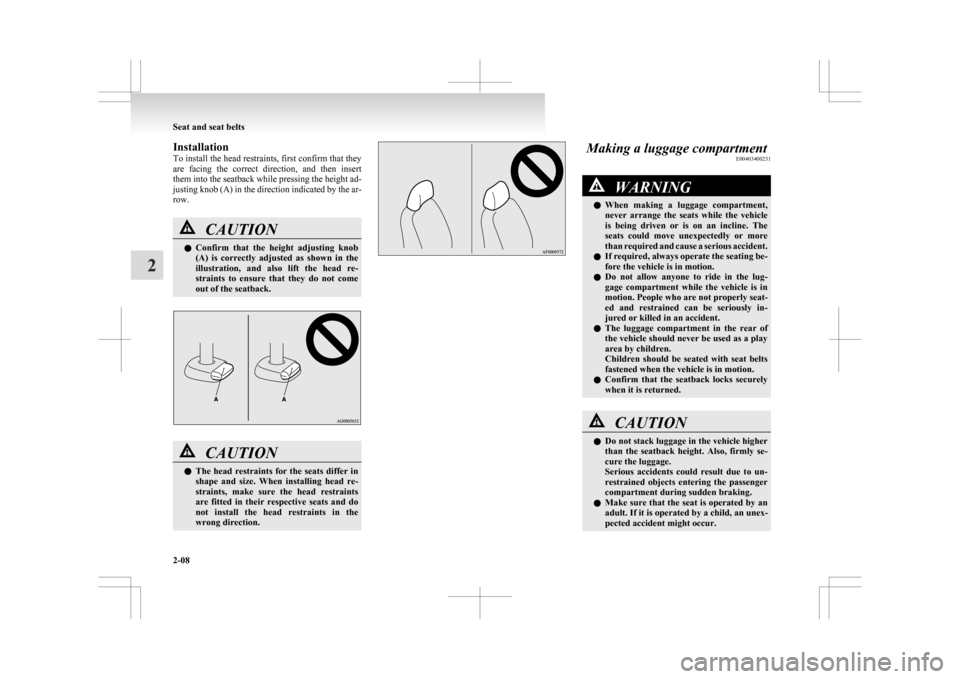
Installation
To
install the head restraints, first confirm that they
are facing the correct direction, and then insert
them into the seatback while pressing the height ad-
justing knob (A) in the direction indicated by the ar-
row. CAUTION
l
Confirm
that the height adjusting knob
(A) is correctly adjusted as shown in the
illustration, and also lift the head re-
straints to ensure that they do not come
out of the seatback. CAUTION
l
The
head restraints for the seats differ in
shape and size. When installing head re-
straints, make sure the head restraints
are fitted in their respective seats and do
not install the head restraints in the
wrong direction. Making a luggage compartment
E00403400231 WARNING
l When
making a luggage compartment,
never arrange the seats while the vehicle
is being driven or is on an incline. The
seats could move unexpectedly or more
than required and cause a serious accident.
l If required, always operate the seating be-
fore the vehicle is in motion.
l Do not allow anyone to ride in the lug-
gage compartment while the vehicle is in
motion. People who are not properly seat-
ed and restrained can be seriously in-
jured or killed in an accident.
l The luggage compartment in the rear of
the vehicle should never be used as a play
area by children.
Children should be seated with seat belts
fastened when the vehicle is in motion.
l Confirm that the seatback locks securely
when it is returned. CAUTION
l
Do
not stack luggage in the vehicle higher
than the seatback height. Also, firmly se-
cure the luggage.
Serious accidents could result due to un-
restrained objects entering the passenger
compartment during sudden braking.
l Make sure that the seat is operated by an
adult. If it is operated by a child, an unex-
pected accident might occur. Seat and seat belts
2-08
2
Page 68 of 368
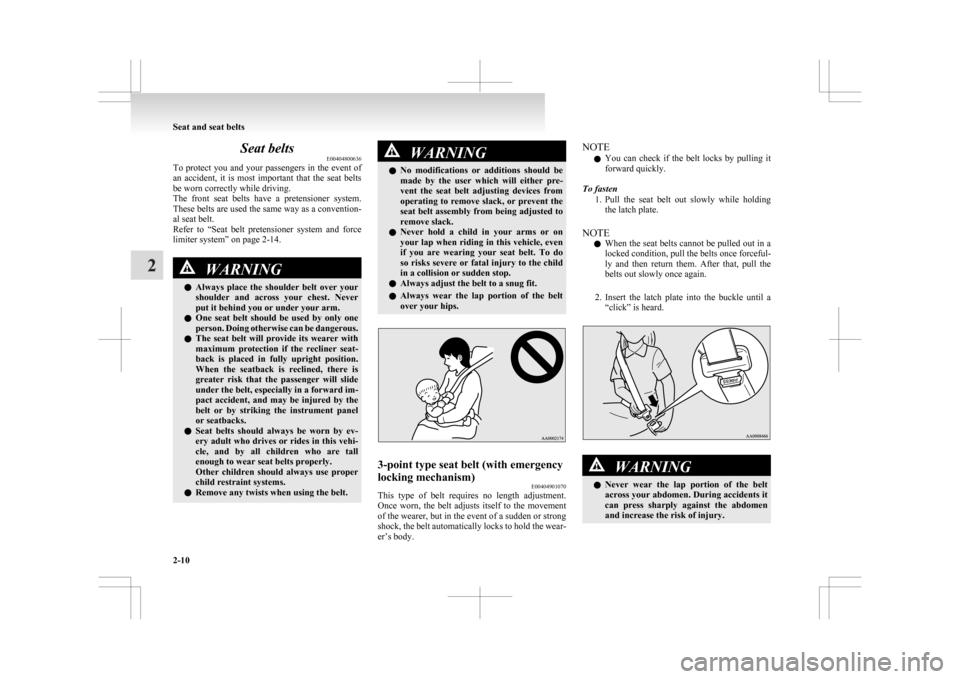
Seat belts
E00404800636
To
protect you and your passengers in the event of
an accident, it is most important that the seat belts
be worn correctly while driving.
The front seat belts have a pretensioner system.
These belts are used the same way as a convention-
al seat belt.
Refer to “Seat belt pretensioner system and force
limiter system” on page 2-14. WARNING
l Always
place the shoulder belt over your
shoulder and across your chest. Never
put it behind you or under your arm.
l One seat belt should be used by only one
person. Doing otherwise can be dangerous.
l The seat belt will provide its wearer with
maximum protection if the recliner seat-
back is placed in fully upright position.
When the seatback is reclined, there is
greater risk that the passenger will slide
under the belt, especially in a forward im-
pact accident, and may be injured by the
belt or by striking the instrument panel
or seatbacks.
l Seat belts should always be worn by ev-
ery adult who drives or rides in this vehi-
cle, and by all children who are tall
enough to wear seat belts properly.
Other children should always use proper
child restraint systems.
l Remove any twists when using the belt. WARNING
l No
modifications or additions should be
made by the user which will either pre-
vent the seat belt adjusting devices from
operating to remove slack, or prevent the
seat belt assembly from being adjusted to
remove slack.
l Never hold a child in your arms or on
your lap when riding in this vehicle, even
if you are wearing your seat belt. To do
so risks severe or fatal injury to the child
in a collision or sudden stop.
l Always adjust the belt to a snug fit.
l Always wear the lap portion of the belt
over your hips. 3-point type seat belt (with emergency
locking mechanism)
E00404901070
This type of belt requires no length adjustment.
Once
worn, the belt adjusts itself to the movement
of the wearer, but in the event of a sudden or strong
shock, the belt automatically locks to hold the wear-
er’s body. NOTE
l You
can check if the belt locks by pulling it
forward quickly.
To fasten 1. Pull the seat belt out slowly while holdingthe latch plate.
NOTE l When the seat belts cannot be pulled out in a
locked condition, pull the belts once forceful-
ly and then return them. After that, pull the
belts out slowly once again.
2. Insert the latch plate into the buckle until a “click” is heard. WARNING
l Never
wear the lap portion of the belt
across your abdomen. During accidents it
can press sharply against the abdomen
and increase the risk of injury. Seat and seat belts
2-10
2